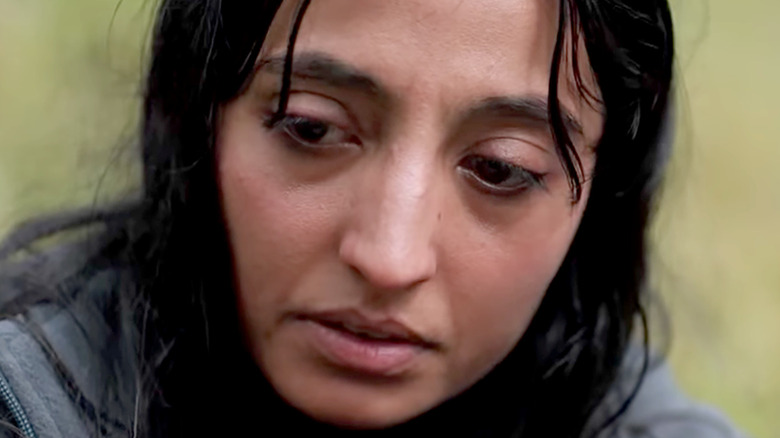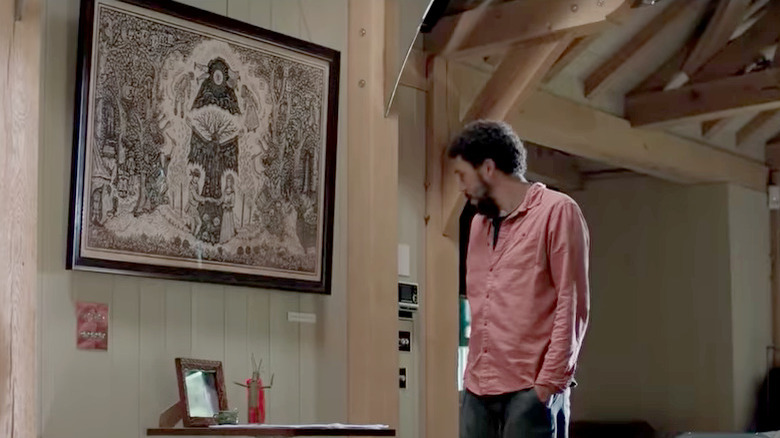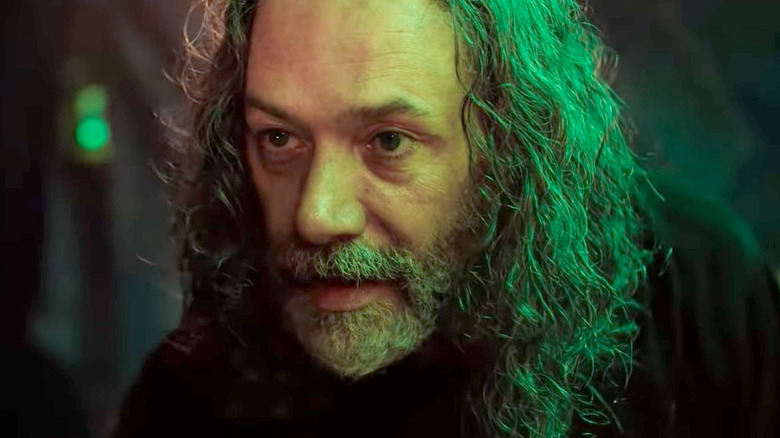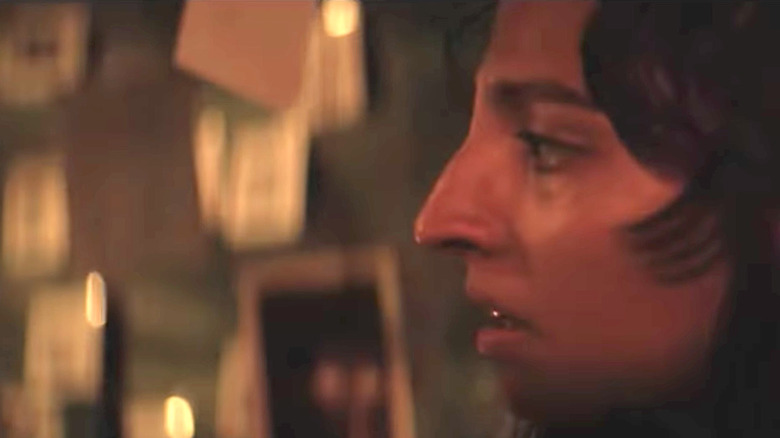The Ending Of In The Earth Explained
The new horror film "In the Earth" got plenty of attention after debuting at the 2021 Sundance Film Festival, thanks largely to comparisons to the COVID-19 pandemic and because of filmmaker Ben Wheatley's ability to combine eco-terror with the occult in an unsettling and visceral way. The movie opens with individuals socially distancing, wearing protective gear, and emerging from quarantine, thanks to a deadly virus that has ravaged the Earth. While the virus depicted in the film isn't COVID-19, it's easy to make comparisons, although the movie's virus isn't the most deadly threat depicted in its story.
Dr. Martin Lowery (portrayed by Joel Fry of the upcoming "Cruella") is studying the region's fertile soil for crop benefits and, after undergoing a series of tests to verify he's virus-free, sets off to join his colleague, Olivia Wendle (Hayley Squires), who has been conducting scientific studies in the woods for months. With the assistance of a park guide, Alma (played by Ellora Torchia of "Midsommar"), Martin sets off into the forest, only for events to continuously take a dark and dangerous turn for the duo.
Science meets the supernatural for a psychedelic twist
To understand the ending, its important to make note of some key plot points throughout the movie. While Martin is in quarantine before venturing into the woods, Alma explains the legend of Parnag Fegg, the Spirit of the Woods, which she describes as a local folktale designed to prevent children from going missing in the forest. Apparently some did go missing in the 1970s, and "This helps keep them more aware," she says. When Martin questions — based on the artwork depicting Parnag Fegg hanging in the lodge — whether the entity is meant to help or harm people, Alma never answers, allowing the suggestion of a negative force to take root in viewers' minds. Later, the two come across an abandoned tent that indicates a family with children had been its occupants. This eerily echoes what Martin was told prior to entering the forest — that many people have gone missing in the woods in recent months. That night, Martin and Alma are attacked in their tents while sleeping, bludgeoned and knocked unconscious by an unseen assailant. Upon awakening, their shoes have been removed and their supplies either taken or destroyed.
Soon after, Martin and Alma encounter a disheveled man living in the woods. His name is Zach (Reece Shearsmith), and he's obsessed with Parnag Fegg, leaving the spirit staged photos as offerings. Martin and Alma become his latest subjects when he drugs them, poses them in a ritualistic manner, takes their pictures, and marks them with strange symbols. This all builds up the mysterious, possibly supernatural atmosphere of the film — similar to what filmmakers did with "The Blair Witch Project" — which plays an important role in trying to decipher the ending.
Or is there a scientific explanation, after all?
Director Ben Wheatley adds to the ending's ambiguity by introducing Olivia Wendle, Martin's to-the-point, science-minded colleague, who believes research can explain the folklore of Parnag Fegg. More specifically, she believes the ancient journals and drawings reveal a way to communicate with nature. Olivia reveals that Zach is her ex-husband, who brought her supplies and helped her set up an experiment to prove that the plant life found in the forest is capable of communication through light and sound. However, the experiments drove him insane. She believes Parnag Fegg isn't a supernatural creature but the trees, fungi, and plants communicating together to affect the people who venture into the forest.
Here, the story moves farther from "The Blair Witch Project" and closer to "The Happening." To prove her point, Olivia argues that she didn't ask Zach to come help her; he simply showed up, claiming he couldn't stop thinking about her and was "called to" the forest. Martin, too, volunteered to check on Olivia because he couldn't stop thinking about her. Olivia deduces that because all three of them had ringworm, Parnag Fegg used the fungi to connect and draw all three of them to the woods. Nature, she believes, is trying to convey a message to them.
As the non-scientist of the group, Alma believes they should leave the camp before Zach discovers them, but Olivia's theory seems to hold true when mushrooms in the forest release a cloud of spores into the air that causes Martin and Alma to experience painful sensations when they try to leave the campsite. It's as if nature is keeping them contained to the spot, proved again when Alma dons protective gear and tries to leave, only to become disoriented and unable to move because of the spores. When Alma questions what message the woods are trying to communicate to them, Olivia responds: "How can we all live together without destroying each other? It's the same as any other creature. It's worried about its environment, food, shelter."
Nothing is as it seems
In the final act of the film, Martin and Alma agree to assist Olivia with her experiments, but Zach arrives to wreak havoc. Here, Wheatley marries the concept of the occult, represented by Zach, with science, as illustrated by Olivia, blurring the ending's meaning and leaving it open to viewer speculation. Zach plans to sacrifice Martin to Parnag Fegg to allow the spirit to communicate openly with them. When Alma recovers and rushes into Olivia's tent to warn the other woman, she discovers Olivia has hundreds of photographs of Zach's posed victims — proving she and Zach have been working together all along.
Alma is able to fight off Olivia and kills Zach, right as the mushroom mist envelopes the camp. After experiencing visions of nature intermingled with their lives, the three survivors have different reactions. Olivia collapses, mutters "Thank you," and seemingly dies, while a calm and smiling Alma emerges into the sunlight. Finding a barely conscious Martin, she tells him, "Let me guide you out of the woods." Alma, who has been the most rational character throughout the movie, still maintains her purpose and poise, proving once again to be Martin's savior. Is it because she's had the least exposure to the fungus or because she's experienced an enlightening supernatural occurrence? Perhaps, the answer is both.
The ending of the film is ambiguous but seems to imply that the folklore and ideology humans embrace can be more harmful and destructive than mother nature. Olivia and Zach seem to have lost their sanity after being exposed to the mushroom spores over several months, driving them to murder anyone who stumbled upon their camp, at least partly because they embraced the local folklore. Martin, who had been exposed to ringworm weeks before, also showed signs of disillusion and interest in the forest's myth, raising the question of whether the ringworm infection was related to the deadly virus that affected the outside world and corrupted their minds. Alma, who never had ringworm, remained the voice of reason and was the most capable throughout the story. This makes it conceivable Olivia was right and Parnag Fegg was the Spirit of the Woods — or the woods themselves were fighting back against its biggest threat: mankind.



